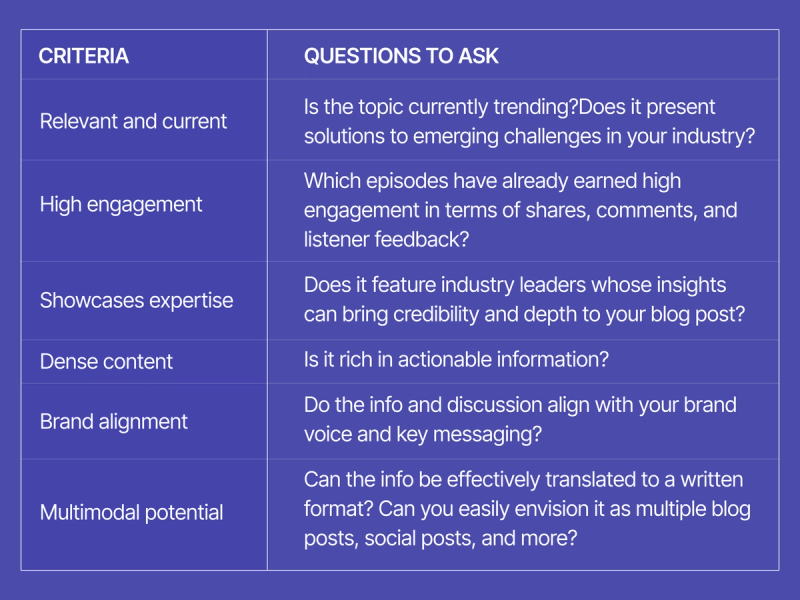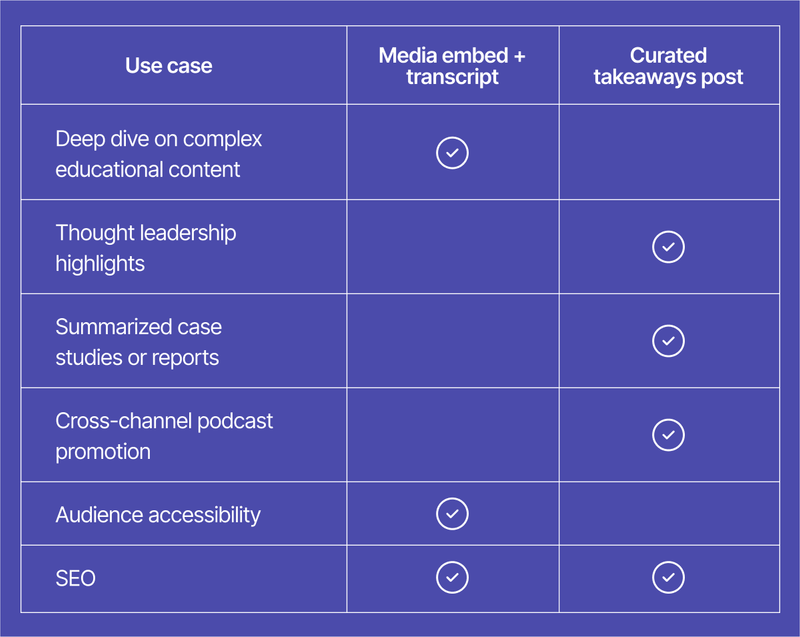7 Steps to Repurpose a Podcast Episode Into a Blog Post

Table of Contents
Maximize Your Marketing ROI
Join 10,000 other marketers already getting the best tips on running engaging events that boost pipeline and create raving fans.
Stuck on the content treadmill? Figuring out how to effectively repurpose content is a challenge for nearly half (48%) of content marketers focused on scaling production.
“As marketers, we have some false assumptions,” explains Greg Swan, Senior Content Marketing Manager at ClickUp, “and number one is because we’ve already created it, everybody’s seen it and it’s old news.”
The reality is that the content you’ve invested in still has a lot of life left. One of the formats with the most “repurposing promise” is your podcast content.
Podcast episodes, especially series, are packed with potential for your content calendar. Plus, they can be resource-intensive to produce, so you should absolutely get the most out of them.
Looking to your B2B podcast for repurposing not only increases your return on that investment; it can also pull a new audience from the repurposed assets you create back to your podcast. (They don’t call it a “content flywheel” for nothing.)
7 steps to repurpose podcast episodes into blog posts
While content marketing has certainly evolved and diversified, the blog post endures as a core format. Let’s dig into a step-by-step of how, exactly, to repurpose a podcast episode into a blog post without a ton of manual work.
1. Choose the right episode
Just like your 4-year-old’s jiu jitsu classmates, every single podcast episode is special in its own way. ❄️ But let’s be honest: Some episodes just land better than others. More importantly, some episodes better lend themselves to being repurposed into blog posts.
The key to picking the right episodes to repurpose is finding that balance between serving business goals and resonating with your audience. Here are a few criteria and questions to guide your selection process.

These considerations will help you identify episodes that provide value to your audience and further your content marketing goals.
2. Enlist the help of AI-powered tools
Now that you’ve chosen an engaging episode to repurpose, let’s talk process.
Of course, you could listen through the episode multiple times, take feverish notes, slide the scrubber back and forth to fine-tune that expert quote… or you could enlist a few smart tools to make things easier.
At Goldcast, we’re on a mission to perfect the art of content repurposing with AI. Here are a few tips and tricks we’ve picked up along the way.
🗒️ The transcript
An accurate and comprehensive transcript is the backbone of repurposing your podcast episode into a blog post. This document captures every detail of the conversation. An auto-generated transcript is rarely (i.e., never) ready for publishing, but it’s really handy to reference and mold as you craft your blog post.
Since there’s little nuance involved in transcript generation, it’s a perfect job for AI. Tools like Otter.ai get it done just fine. For a free, MacGuyver-esque hack, you can even transcribe your audio file using Google Docs’ Voice Typing tool—though the result won’t have timestamps.
If your podcast has a video component, simply use your video tool to generate a transcript. This feature is built into most tools, including Goldcast’s Content Lab (pro tip: transcript creation is free for up to 1 hour of video per month!).
🎥 Adding video snippets
Speaking of video, if you have it for your podcast episode, it should absolutely go in your blog post as well. Video snippets and other visual elements can give your post a huge engagement boost. They help break up large blocks of text and give the reader a more dynamic context.
Once you have your transcript, you can pull AI back into the content creation process by asking it to identify video clips and soundbites that would work well within your blog post.
🔎 Search engine optimization (SEO)
Unless you started your marketing career yesterday, you already know optimizing for search is crucial to maximize your blog post’s reach.
The nice thing about creating a blog post from podcast content is that you don’t have to start from scratch on SEO. Some AI content tools can work from your video or transcript to identify:
- Focus keywords
- Headings and subheads
- Content gaps
Incorporating AI into your podcast repurposing process isn’t as simple as asking ChatGPT to write a blog post from your transcript and clicking “publish.” It can, however, remove some of the manual work and get your creative juices flowing—which gives you a polished post sooner.
3. Choose your structure: Transcripts vs. takeaways
Should your podcast-turned-blog post be a complete transcript or curated takeaways? It won’t surprise you to learn that few people want to read your verbatim podcast transcript. However, transcripts serve several other purposes, so it often makes sense to create both a raw transcript and structured show notes:

In most cases, an edited, structured blog post discussing key takeaways is the best way to repurpose your podcast content. However, if your audience is interested in comprehensive, verbatim details straight from the speaker’s mouth, it might make sense to make the transcript available.
There may only be a few sweet souls who read your transcript, but the search engine crawlers definitely will. So will accessibility tools. That’s why you’ll want to publish a transcript somewhere along with your podcast episode—just maybe not on your company blog.
4. Craft your key takeaways blog post
We won’t get into all the details of perfecting your blog post—you can check out our resources on AI blogging and using video in blog posts for that.
As you’re gearing up to put your post together, though, it’s important to remember what makes a podcast episode such an excellent source for blog content:
EEAT (Experience, Expertise, Authoritativeness, and Trustworthiness).
In a sea of AI-generated articles, EEAT is the way you’ll stand out. You might be familiar with EEAT as an SEO component, but the reason search algorithms look for these markers is because they signal high-quality, high-value content.
Your podcast episode is essentially EEAT in audio form. You have a long-form, first-person account from an expert to work with. Talk about a gold mine! 🪙
Simply summarizing the main points of the podcast overlooks the opportunity to highlight your guest’s expertise and make your post shine.
Here’s what to do instead:
- Summarize your key points
- Be sure to “introduce” your guest in the post, including their credentials and background
- Identify at least one salient quote for each point
- Incorporate any personal anecdotes the guest shared
These elements will take your post to the next level in terms of value, relevance, and SEO. Plus, they’re uniquely human—no AI tool can replicate them.
That said, AI can help you identify them and organize your content with the right prompts.
5. Publish and promote the blog post
At last, your content is ready to publish on your blog and social media channels. Effective distribution strategies can give it that extra push to reach a wider audience and make a bigger splash. Here are our best tips:
- Share snippets and a strong CTA in your next email newsletter.
- Let your new episode’s guests know when the blog is published, and provide easy promotion assets for them to share on their own channels.
- Consider paid social ads to boost your content’s visibility.
- Engage in social conversations around your post’s topic, sharing insights from the discussion and sending traffic back to your blog when organic.
Distribution and promotion are the last pieces of the content ROI puzzle. Don’t leave them out of your podcast repurposing plan—they’re where you’ll really start to see your effort pay off.
6. Repurpose for multiple platforms
Since you’re already reworking your podcast episode, don’t stop at the blog post. Repurposing the piece for different platforms helps you get even more value from the content you’ve invested in creating. Consider different formats like:
- Social media posts (quotes, takeaways, Q&A, video clips, infographics)
- Email marketing (sales, newsletters)
- Case studies
- Whitepapers
When it comes to repurposing content for social media platforms, you know your audience better than anyone. Where do they hang out and consume the type of content you’re creating?
Whether it’s LinkedIn or Reddit, tailoring your content to the platform is vital for maximum impact.
On LinkedIn, for example, you can publish a version of your blog post as an article with minor tweaks, like tagging podcast guests. You could also chop it up into a series of short posts, ready to share on your company page or from a thought leader’s personal account.
Content repurposed for X (formerly Twitter) looks much different. Since brevity is the name of the game, you’ll need to identify those hard-hitting snippets that capture attention and spark curiosity.
With some guidance, AI can help you highlight key points, condense information, and adjust the tone for whichever platform you pursue.
7. Use blog posts to drive demand generation
Blog posts are a gateway to deeper engagement with your audience. Whether someone lands on your blog from search results or a social media share, you have one chance to nail the first impression. One chance to make them want to see your brand again. Like a first date. 💃🏼
Here’s how to keep readers coming back for more content:
🙏🏼 Lead with value. Provide genuine value in your blog post by addressing specific pain points or audience interests. Surface-level or overly promotional content won’t bring readers back for more. In fact, it might deter them from clicking your article the next time they see you on the SERP.
⏭️ Use clear CTAs. If you want someone to do something, ask. A reader should never get to the end of your blog post without knowing the next way to engage with your brand. Whether it’s subscribing to your podcast, signing up for a newsletter, or scheduling a demo—be specific.
🧲 Create lead magnets. Give away plenty of value for free—but for downloadable guides and exclusive on-demand content, it still works to ask for users’ contact information. Consider sprinkling CTAs for these high-value resources near the top or middle of your blog post, rather than leaving them for the end.
📈 Track and optimize. If lead gen is your goal, monitor metrics like signups and conversion rates to understand what works and what doesn’t. Use these insights to optimize your CTAs, structure, and content.
Bonus tip: Use insight-rich podcasts to brainstorm new content
Repurposing a podcast episode into a blog post is just the beginning. Because of their in-depth nature, podcast discussions are treasure troves of content inspiration. They can serve as a cornerstone of your content strategy, similar to webinars and other virtual event recordings.
You can mine these rich conversations for a wealth of fresh ideas to engage your audience. A single episode can spark a dozen or more new topic ideas. For example, you can build out a topic cluster around a few minutes of discussion on one key pain point.
Brands that have been creating content for a while often struggle to come up with new topics for their blog. Podcast guests offer a solution to this problem because:
- They’re external to your team or organization, so they bring new perspectives, and
- They’re experts in their area, so they have nuanced and thorough takes.
The bottom line is: You’ve already invested in significant legwork by identifying a subject matter expert and hosting them on your podcast. Now, make the most of that conversation to inform the rest of your content marketing strategy.
Create search-optimized multimodal blog posts with Goldcast Content Lab
Repurposing your podcast episode into a blog post doesn’t have to be tedious. With a thoughtful and efficient process, you can automate some steps while focusing your strategic creativity where it really counts.
Don’t have a podcast? You might be sitting on one without realizing. If you host topical, expert-led conversations—congratulations, you have a potential podcast. You can repurpose virtual events like webinars and panels into podcast episodes, just like the folks at BambooHR.
After one year of repurposing their HR Unplugged event series, the HR platform was averaging more than 1,400 registrations, 400 attendees, and 2,500 monthly podcast downloads for each event. That’s 2,500 additional people reached twice a month, with just a little extra work.
Goldcast Content Lab makes repurposing your long-form video and audio content a breeze. Our AI-powered repurposing platform helps you create on-brand, media-rich content in minutes.
Ready to generate 20x more content from your podcast and events? Try Content Lab now—it’s free.
Transform Your Video Marketing with AI
Stay In Touch
Platform
Resources
© 2025 Copyright Goldcast, Inc. All rights reserved.





 Upcoming Events
Upcoming Events Event Series
Event Series On-Demand Events
On-Demand Events

